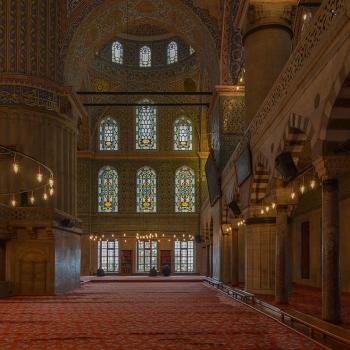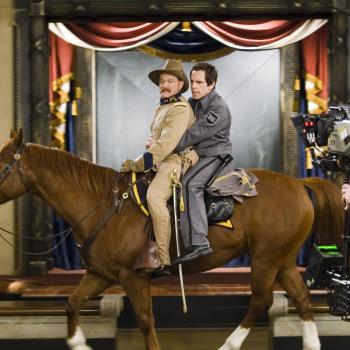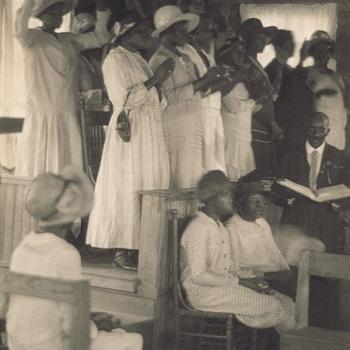No one really knows on what day Jesus was born. Many biblical scholars understand inferences to shepherds in fields from the New Testament, as well as Zechariah’s priestly service, as pointing to a birthday in mid-September or early October. That means that Jesus may have been conceived in December but most likely was not born on December 25.
But at least Christians who celebrate the nativity do so on the same day each year. Christmas may occur on a different day of the week, but it always coincides with the twenty-fifth day in the last month of the year.
The same cannot be said for Good Friday, which some years occurs during the first round of the NCAA men’s basketball tournament (March Madness) and sometimes happens after Major League Baseball has launched its season. Sometimes it even overlaps with The Masters’ Tournament, “a tradition unlike any other.”
Why professional golf would be more fixed than the day on which Christ died for the sins of the world is a mystery. Actually, it has a lot to do with lunar patterns and the celebration of Passover to which the bishops peg the church calendar. But this still makes no sense. Practically every person has a fixed day of birth and death. Jesus has the former but not the latter. Thanks to the machinations of the church calendar, Jesus dies on a different day every year. Many scholars believe that April 7, 30 (AD) or April 3, 33 (AD) were the most likely dates. We are close, but no cigar in 2018
If you are going to move it around, the Reformed Protestant solution is to follow the catechetical calander. Some Reformed Protestant pastors are quick to notice that even though their churches don’t do Advent or Lent, such communions as the Netherlands State Church, included in their church order instructions to observe five days from the Roman calendar–Christmas, Epiphany, Good Friday, Easter, and Pentecost. Reformed church historians will shoot back that the Dutch authorities were not the most reliable magistrates ever to oversee a Reformed church–they let Descartes live among the observers of Christmas and Epiphany, after all, when the rest of Europe would not have the envelope-pushing philosopher. These historians will also argue that the retention of these five holy days was a concession to keep the former Roman Catholic–now Protestant–population happy.
But Reformed Protestants have an alternative. If you cannot answer the question, “what’s wrong with once a year calling attention to the birth and resurrection of Christ?,” readily, say with something like, “well, why don’t we also observe and celebrate every year the announcement to the virgin Mary of her conception?,” then try this.
The Heidelberg Catechism is divided into 52 Lord’s Days. Print versions break down the 129 questions and answers into units that Reformed pastors are expected to preach in the second Sunday service. Similar expectations were responsible for bringing Christians to services on Christmas, Epiphany, Good Friday, Easter, and Pentecost. It might have been a smart trade — five Holy Days for a second service each Sunday based on the catechism.
Now if you look at those Lord’s Days in the catechism where questions and answers cover the incarnation and the crucifixion, you find that the fourteenth Sunday is the one where Christmas comes up, and the seventeenth is when the catechism gets to the death of Christ on the cross. That means that Reformed Protestants who followed the Heidelberg Catechism and wanted to reflect every year on the birth and death of Jesus would observe Christmas on a Sunday somewhere in mid-April and Good Friday sometime in early May.
The downside is the lack of commercial benefit for such close proximity of Christmas and Good Friday. You have three weeks to squeeze in all the festivities of Christmas and the sober reflections of Holy Week that occur during plans for loading up on flowers and chocolate. And as Leigh Eric Schmidt taught us in his book on Christian holidays, markets and consumption generally matter for both Christians and non-Christians in the West than piety:
Easter, even more than Christmas, remained under a Puritan and evangelical cloud in the antebellum United States. Though various denominations preserved the holiday — most prominently Episcopalians, Roman Catholics, Lutherans, and Moravians — their celebrations were, until the middle of the century, local, parochial, and disparate. The festival only became a nearly ubiquitous cultural event in the decades after 1860 as low-church Protestant resistance or indifference gave way to approbation and as Episcopalian, Roman Catholic, and new-immigrant observances became ever more prominent. Middle-class Victorians, as fascinated as ever with the romantic recovery of fading holiday traditions and the cultivation of new home-centered festivities, discovered lush possibilities in this spring rite. . . .
In an article on Easter published in 1863, Harper’s New Monthly Magazine suggested the growing embrace of the feast in American culture. “It is one of the obvious marks of our American religion,” the article related, “that we are noticing more habitually and affectionately the ancient days and seasons of the Christian Church.” Easter, following Christmas’s rising popularity, showed “unmistakable signs that it is fast gaining upon the religious affection and public regard of our people.” “We have carefully noted the gradual increase of observance of the day,” the journal continued, “and can remember when it was a somewhat memorable thing for a minister, not Catholic or Episcopal, to preach an Easter sermon.” What the magazine found most revealing of “this new love for Easter,” however, was the increasing use of elaborate floral decorations for the festival. “Easter flowers are making their way into church of all persuasions,” the magazine applauded. “One of our chief Presbyterian churches near by decked its communion-table and pulpit with flowers for the third time this Easter season.” . . .
In lauding Easter flowers, the Harper’s piece was celebrating the expanding art of church decoration. As a liturgical movement, this art bloomed in England and the United States in the middle decades of the nineteenth century. An outgrowth of the ritualist or Catholic turn within Anglican and Episcopalian circles, the new forms of church decoration meshed with the Gothic revival in Victorian church architecture and ornament. (Consumer Rites, 195, 196)












